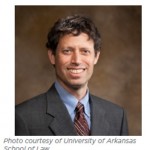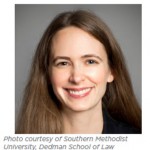Spotlight on Sections: Section on Criminal Justice
By Barbra Elenbaas
AALS Sections provide a forum for law school faculty and staff and to connect on issues of shared interest. Each of the 100 AALS sections is focused on a different academic discipline, affinity group, or administrative area. For a full list of AALS sections and how to join, please visit www.aals.org/services/sections.
The Section on Criminal Justice promotes the communication of ideas, interests, and activities among members and facilitates and promotes the development of the scholarly, pedagogic, and public service efforts of Section members.

Laurent Sacharoff, University of Arkansas School of Law – Fayetteville (Chair)

Meghan J. Ryan, Southern Methodist University, Dedman School of Law (Chair-elect)
: We are law professors who teach both or either substantive criminal law and criminal procedure. Our membership also researches and writes in a variety of areas of the law including such topics as plea bargaining or sentencing. That’s important because 97 percent of federal cases (and also many state cases) are resolved by way of a plea bargain. Finally, we have members who research or teach incarceration topics. This has become an important topic because we [in America] incarcerate five to 10 times as many people
per capita as European countries, and because of the racial disparities in our incarceration rates.
Meghan J. Ryan: We also have a pretty engaged membership both on scholarship and legal issues. We’re generous in giving comments to each other on paper drafts, helping with teaching questions, and other issues that come up.
LS: On the personal level, members of the group are supportive of each other, friendly, and fun. Many of us are former prosecutors or public defenders or trial lawyers of some sort.
How do you interact or collaborate outside of the Annual Meeting?
MR: We have two active listservs that we use. Every day there are probably anywhere from five to 30 emails that go back and forth discussing hot topics in the law. We also talk more substantively about aspects of criminal law, like what’s the evidence necessary to prove rape, or procedure issues affected by some recent Supreme Court or circuit court cases. We talk a lot about issues that are unresolved, and debate what the right answer is.
LS: We also have CrimFest, a criminal law conference organized every summer by our section Secretary Carissa Hessick (University of Utah, S.J. Quinney College of Law). That’s a nice supplement to AALS, more informal and workshop-oriented. It’s pretty well-attended, and has a nice feature where people who are on the job market and currently doing fellowships will present their papers and network. And there are other, even smaller conferences—one at Texas Tech, and the American Bar Association has a conference that AALS sometimes participates in.
MR: We’re bigger than just our participation in AALS. The AALS Annual Meeting is very useful and it provides a framework for structuring our community. The AALS section is the clearest home for us, but it’s really a community of scholars.
What kind of resources could one find on your AALS section website? It is one of the more robust section sites. How do you handle its management?
LS: This is something that I’m interested in improving. Right now the site has our biannual newsletter, which recaps peoples’ publications and previews panels that are coming up at AALS. But the website can be hard to use. I’m excited to make it a better resource by having it more web-based than download or document-based.
We post the same things from year to year. We post the newsletter, we post the call for papers. We post them simultaneously as an announcement and on the listserv.
MR: Usually we’ve had the secretary post the newsletters since the secretary is the one responsible for putting them together. Laurent has been really great in trying to make our website better and providing a little more consistency from year to year even though our positions change as we progress through the Executive Committee.
How does your section support the scholarship of your members?
LS: One new initiative that our section Secretary Carissa Hessick is spearheading is a more formal mentoring program. The section will link up junior faculty with more senior mentors to help with their careers, but more specifically with their scholarship. We also host an award for junior faculty, through a call for papers.
MR: Every once in a while, AALS co-sponsors a workshop with the Academics Committee of the American Bar Association’s Criminal Justice Section. The goal is to have some cross-fertilization of ideas and work between law school faculty and practicing lawyers, and also to help practicing lawyers transition into teaching. That can be difficult sometimes—first to get the job, and then to develop good scholarship and good teaching. At the event, AALS co-sponsors a writing workshop day, which really helps people improve their papers, improve their scholarship, and hone their ideas.
Also, there is the more informal aspect of having a community via listservs and the structure of our section more broadly. That helps to facilitate networking among law faculty, which then leads to making friends and commenting on people’s papers so they can improve in that way as well.
Do you have any advice to offer other sections looking to increase their member engagement?
LS: One of the interesting things we do in the Criminal Justice Section is when we try to decide what panels to hold at AALS, we on the Executive Committee don’t decide unilaterally. Instead, we prominently announce a call for panels. We see numerous applications—10 or more per announcement, and we engage the community through this method.
A new effort we tried this year, at the suggestion of new Executive Committee member Eric Miller, was to reserve one spot on that panel. Once we selected the two panels to sponsor, we put out another call for people to nominate someone (or themselves) to fill the final spot on the panel to increase diversity. Viewpoint diversity, racial diversity, gender diversity—the original panels very much are [trying to focus on diversity] when they are first organized. But Eric proposed, and we all thought it was a great idea, that we enhance diversity further this way. We were hoping this method would allow us to say ok, maybe this panel has some people who are familiar and have been on AALS panels before. Now we have the opportunity to make sure someone on the panel is a person we’ve never heard from before.
MR: We look at school diversity, as well. I think a lot of sections have different ways of creating panels. I think sometimes it’s the Chair’s prerogative to organize and be on the panel themselves. But we have such an engaged membership in the Criminal Justice section that people want to be on the Executive Committee [and panels], make a difference, and bring people together.
One of your sessions at the 2016 Annual Meeting centered on the rise of technology and a data-driven criminal justice system. Is this a trend scholars have been seeing in the field?
LS: The use of predictive policing is one trend we’ve seen. Others include Fourth Amendment issues, as well as the use of data to predict, in various contexts and criminal systems, where to police. Also, predictions for setting bail and sentencing.
It’s a trend in our entire culture. The issue is controversial because on the one hand, data gives us the tools to make smarter decisions and better predict which parts of a city might be more likely to see crime, or which defendants are more likely to be a flight risk or a danger to the community in the bail situation. On the other hand, data poses the danger of repeating stereotypes—racial stereotypes. If big data says we need to patrol this part of the city more but that’s just repeating stereotypes based on previous patrolling habits, convictions, or arrests—more likely arrests—then there’s a downside. There’s also the privacy downside of data.
What made the panel interesting was that the participants were engaging both sides of that controversy. They weren’t anti-data, and they weren’t naively pro-data. They were engaging in the difficulty of that discussion, and in the use of data throughout the various stages in the criminal justice system.
What sorts of section activities are you considering for next year’s Annual Meeting?
LS: We’ve submitted proposals for two panels. One of them is a 50-year anniversary of a landmark criminal justice report. It will be a panel on where we stand now, particularly with regard to mass incarceration, but also with other issues dealing with criminal justice.
MR: The name of that report is “The Challenge of Crime in a Free Society.”
LS: The other panel is on false confessions.
MR: I don’t know if it’s known to a lay audience. A lot of people think that if someone confesses to a crime, that’s definitive evidence or proof of guilt because who would confess to a crime they didn’t commit? But social science evidence has established that there are a lot of people who falsely confess, which leads to wrongful convictions. And for both panels we have a great lineup of experts in these areas.
You also host a junior scholar award, which is given out at the Annual Meeting. Why is it particularly important to honor upcoming scholars in the criminal justice field?
MR: Sometimes as a junior scholar it’s hard to get noticed, especially by scholars who are very well-known in the field. The members of our section’s Executive Committee read all the papers that are submitted for the award. So that’s one opportunity, regardless of whether you win the award or not, to get more people reading your paper and possibly giving comments on it.
What is your vision for the section, this year and in the years to come? What new initiatives, project-based or ongoing, would you like to see as part of the section?
LS: I think the big one for me is to make the website a true resource for professors. One that’s easy to use, easy to get on to, has links. Because there are a variety of resources for professors that are in disparate places such as teaching materials. We want the website be a clearinghouse for these resources.
The mentoring program is something that we’re all very excited about over the next few years. We have a lot of mentoring that goes on informally, but to have something more institutionalized would be great for newer faculty and the future of the field.
Finally, I think continuing to increase who is involved in the section and in leadership, including diversity of all sorts, but particularly school diversity. I don’t want to imply that that hasn’t been the case in the past. It’s just something that we’re cognizant of and everyone on the committee now is committed to being more intentional about that moving forward.
MR: The other thing I’d add is in addition to formal mentoring, I think the Criminal Justice Section membership is really great in engaging in informal ways as well. Not only can you engage in networking at the Annual Meeting, but it’s also fun to see people you haven’t seen for a year and see what they’re working on. So I hope we can continue that tradition as well.